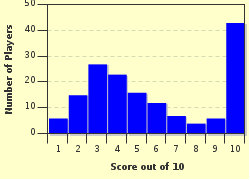Quiz Answer Key and Fun Facts
1. Under the 18th dynasty pharaohs, the army became a unified and well-trained force. Each division was named after a god. The pharaoh had a war council to assist him in making decisions. When Ramesses II came to the throne in about 1279 BC as third pharaoh of the 19th dynasty, the army was a formidable war machine. Under the protection of which deity was the pharaoh's personal bodyguard placed?
2. As young ruler, Ramesses II set out with the four army divisions to recapture Kadesh on the Orontes river in western Syria. Waiting for him was the Hittite army with 18 allied and vassal states, massing forces about twice as large as the Egyptian army. However, Ramesses II had an unusual mascot that he took with him into Syria, one that had saved his life on several occasions.
3. The Egyptian army left Egypt along the Gaza route through Canaan, along the Sea of Galilee to encamp about one day's march south of Kadesh. Ramesses rode in advance with his bodyguard, leaving the other divisions to follow. Seemingly waiting for the customary declaration of war and negotiations about the date and venue for the battle, Ramesses settled in with his mascot at his side while priests erected a portable shrine in the camp.
Before long, two deserters from the Hittite army were found lurking around the camp. Beaten for information, they said that the enemy forces lay in the land of Aleppo, well to the north. It was a rouse, however, as the Hittites were encamped on the other side of Kadesh mound, waiting to attack.
Sources differ about whether Ramesses actually believed the information or not, but his army moved off to Kadesh while a message was sent the other divisions to hurry up. From where did the first attack come?
4. Outside Kadesh, the sight was awesome. A detailed, if biased, account of the scene is found in the Pentwere Papyrus. The scribe penned: "His Majesty reached the town of Kadesh. The despicable Hittite enemy had gathered foreign countries around him. An awesome number, without parallel. It covered the hills and valley and because of its size, was like a swarm of locusts."
At that point, Ramesses' grandiose autobiography took on the gleam of glory. Relating how he and his bodyguard stood alone against the enemy, the pharaoh boasted later: "I found the 2,500 chariots in whose midst I was, sprawling before my horse." Nevertheless, Ramesses was in serious trouble and only saved by the unexpected arrival of who?
5. Ramesses picked up the pieces of his broken army and returned home. He is quoted as having described them as cowards, "I will not reward any of you, as you abandoned me when I was alone fighting my enemies." How many more years of minor skirmishes followed before the two kings signed a peace treaty?
6. After the Hittite king's death, Hattusilli III usurped the throne from the crown prince, who fled to Egypt and was granted asylum by Ramesses. Hattusilli wrote to the pharaoh, demanding the return of the prince, and on being refused, recorded: "Therefore there was anger between me and the king of Egypt."
The deposed Hittite prince remained in Egypt for another ten years. Relations between the two countries were tense. Hattusilli only sent a handicapped slave as a gift after Ramesses sent him doctors loaded with herbs. What event finally put out the flames of animosity?
7. The famous peace treaty lasted for 46 years until the Hittite empire fell to the Sea Peoples, a mixture of Philistines, Sherden, Etruscans and Sicilians from the Mediterranean region and Asia Minor. By that time, Ramesses' son Merneptah was on the throne and had to deal with the threatening wave moving towards Egypt.
The Sea Peoples entered the eastern delta, joining the Libyans who were also attempting to share the riches of the Nile Delta. Gradually, the newcomers moved down to Memphis, the capital city, with the intent to conquer it. Merneptah imitated his illustrious father and fell upon the enemy in fury. According to the stele at his funerary temple, how many did he kill in an six hour long battle?
8. The Sea Peoples did not give up their ambition of conquering Egypt. Taking advantage of the political instability that followed the end of the 19th Egyptian dynasty, they attacked the Nile delta when Ramesses III was in the 8th year of his reign. Ramesses III is considered the last great pharaoh. In his time the Trojan War took place and Mycenae fell, throwing the Mediterranean into turmoil.
In the longest hieroglyphic inscription known, Ramesses III recorded the battle on the walls of his Medinet Habu temple. The Sea Peoples not only arrived overland with ox-carts packed with belongings and families, but also by means of what other transport?
9. Three years after the previous troubles, the Libyans returned. Immigrants gained access via the Canopic arm of the Nile in the western delta. Ramesses III set upon them again, leaving 2,000 dead. He duly inscribed his victory on the walls of Medinet Habu.
Unfortunately, the greatest threat to the king's life came from his own palace. One of his secondary wives headed an assassination plot in order to place her own son on the throne. How many people were eventually implicated and put on trial for the failed coup?
10. Finally, the crown prince who actually made it to the throne, Ramesses IV, was involved in some minor skirmishes with the Sea Peoples, but he preferred to mount expeditions to the turquoise mines and Nubia. His son, Ramesses V only reigned four years. What deadly enemy ended the young king's life?
Source: Author
sterretjie101
This quiz was reviewed by FunTrivia editor
bloomsby before going online.
Any errors found in FunTrivia content are routinely corrected through our feedback system.

